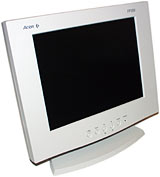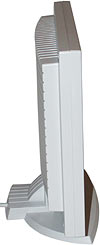
Acer FP350 LCD flat panel monitor
Review date: 3 October 2000.Last modified 03-Dec-2011.
Want a cheap LCD monitor?
Tough.
They're expensive.
Liquid Crystal Displays cost a lot more than ordinary Cathode Ray Tube (CRT) monitors.
LCD monitors may be slim, and light, and run cool, and not consume much power, but behind every single pixel on the screen are three transistors. There's one for each of the red, green and blue "subpixels" that make up the whole pixel. A 1024 by 768 pixel LCD panel therefore contains 2,359,296 transistors, and it's really difficult to make them without some of those transistors being defective. In fact, it's practically impossible.
Because of the manufacturing difficulties, LCD panels are really, really expensive compared with CRTs. A 15 inch LCD costs about $AU2000. So it's nice to find a cheaper one.
Acer's FP350 certainly is cheaper - at $AU1210, it's the least expensive proper active matrix 1024 by 768 LCD monitor I've ever seen. I've seen it advertised by American discounters for $US550.
This means the FP350 still, of course, costs more than many 19 inch CRT screens. But by LCD standards, it's a cheapie.
Vital statistics
LCD monitors don't mess about with their size figures; CRTs do. A "15 inch" CRT screen will generally only have about a 14 inch viewable diagonal. Most CRT monitors these days are similarly over-specified - subtract an inch, in the absence of other data, to get the real size. But a 15 inch LCD screen really has a 15 inch viewable diagonal - none of the display area is covered by the plastic surround.
The FP350, though, isn't a 15 inch screen. Or even 14 inch. It's got a 13.3 inch panel, the same as is used in many cheaper laptops. The display area is 270.3 by 202.8mm in size, and you'd better believe the part after the decimal point matters.
A decent quality "15 inch" CRT monitor with, say, a 14 inch viewable diagonal, will give you nearly 11% more screen area than the FP350, and only cost $AU300.
This is what you're paying for, folks. The FP350's 372mm wide, 339mm high and only 170mm deep (14.6 by 13.3 by 6.7 inches). And that depth figure's the depth of the plinth the screen stands on - the main body of the FP350's less than 70mm deep.
For comparison, your average cheap 15 inch CRT screen is likely to be about 15 inches deep. The desk space difference is considerable.
And it's light, too. The FP350 weighs only 4.6 kilograms; a 15 inch CRT's going to be about 12 kilos.
Setting up
Like many other LCD screens, the FP350 has a separate mains adapter that connects to it via a simple DC barrel plug. The fat IEC lead can therefore end under the desk, with only the slim DC cable and the video lead marring your aesthetically immaculate pose - I'm sorry, I mean work - area.
You get an impressively thick manual with the FP350, but that's only because it says the same thing in seven languages. No matter; setup is simple. Windows monitor info files are included, but you can make do with default monitor settings if you prefer, or if you're not running Windows. It'll work just as well.
The FP350 gives you the usual collection of simple control buttons and an on-screen display to set the monitor up. The "i key" button on the left is the auto-setup key, a standard feature for LCD monitors. Auto-setup analyses the incoming signal and fits the display to it as well as it can. The FP350 does an excellent job of grabbing a 1024 by 768 signal.
Mind you, I wasn't very impressed with the FP350's display in 800 by 600 and 640 by 480. It was a bit fuzzy, as are all LCDs when they're stretching a lower resolution image onto all of their pixels, but it also had a definite case of dot crawl - pixels that didn't quite map onto one or another display pixel, and made the image vibrate a bit. This was most noticeable in large areas of mid-brightness colours, like a Windows desktop.
On many LCDs, you can tune this quivering out by fiddling with the settings, but on the FP350 nothing I did seemed to help.
This isn't much of a complaint, though. You're not meant to use LCDs in resolutions other than their native one. The FP350 looks unusually crummy in lower resolutions, but if you're only passing through those resolutions as you boot your computer or when you've changed your video drivers or something, it's not an issue.
Some LCDs support a resolution one step higher than their actual physical pixel count - say, 1280 by 1024, for a 1024 by 768 screen. They don't display it very well, of course, but at least you can use the computer.
The FP350 doesn't do this. If you feed it a bigger-than-1024-by-768 signal it just sits and sulks until you go back to a resolution equal to or smaller than its real dot count. It works with various unusual resolutions below 1024 by 768, though.
Image quality
The FP350 might not be a very big screen, but it's still got the razor-sharp pixels and dead flat display of every other LCD.
It's also commendably light on the defects.
Remember how I said it was practically impossible to make an LCD panel without some dud transistors? Well, what that means is that you have to put up with defects on most LCD screens.
To keep LCD panel prices at least somewhat realistic, manufacturers allow a few dud subpixels on most of the panels. Some panels are flawless, but most have a defect or three. You won't necessarily notice the defects, though - a dead subpixel or two in the corners of the screen really isn't easy to spot.
There are two kinds of stuck subpixels - stuck on and stuck off. Stuck on subpixels show up on dark backgrounds, because they're always lit. They may or may not be lit to full intensity, though. Stuck off subpixels show up against light colours, because they're always dark. There are quality control rules to keep the defects as un-noticeable as possible - only so many defects are allowed, and where a defect is affects its tolerability, and clusters of defects aren't allowed. Only if all three subpixels for a given pixel are defective will the pixel really stick out like a sore thumb.
But, if you've just dropped big bucks on a new screen, and you didn't know about the defect issue, you might well be a tad honked off to discover your expensive monitor has some unexpected speckles.
On this count, the FP350 scored well. The only defect I could find was one dimly stuck on pair of adjacent subpixels - a red and a green. If they'd been stuck on at full brightness they'd have been quite annoying, but as it was I had to dismount the body tube and optics from my microscope and hand-hold it pointing at the screen (as you do) to see just what the deal was.
Now, you can't make statements about the quality of a line of monitors by looking at just one of them, but this was just a plain off-the-shelf unit, not a specially picked low-defect review model. So I think you've got a decent chance of getting a nice low dud pixel count if you buy an FP350.
The down side
In some other respects, though, this monitor isn't all that great.
Viewing angle, for instance.
Really old LCD screens, like the passive matrix units in old laptops, have painfully narrow viewing angles. You have to look at them at an angle very close to perpendicular to the screen surface; get a bit off-axis and everything goes funny colours.
This is because of the polarisation-based way in which LCD display devices work. The actual liquid-crystal part of an LCD isn't luminous. All an LCD can do is try to block the light coming through it from, in the case of a flat panel screen, its fluorescent backlight. Every subpixel has a coloured filter so that when it's not blocking light, that light comes out red, green or blue. If you get off-axis, though, you're looking through the stacked filters and polarisers at the wrong angle, and things get weird.
Off-axis distortion's different depending on whether you're offset horizontally or vertically from the screen. Many LCDs have different horizontal and vertical viewing angle specifications, and the horizontal angle's wider. The theoretical maximum possible angle is 180 degrees; lots of decent LCDs these days manage 120 to 140 degrees horizontally, and some better ones manage 160.
The FP350, on the other hand, only has an 80 degree horizontal viewing angle. That's not too bad, for a small screen, but it's not good either.
The FP350's vertical viewing angle's nothing to write home about, either. Again, really good LCDs now manage a 160 degree vertical range, but the FP350's only good for 20 degrees up and 35 degrees down, for a 55 degree total range.
Look up at an LCD panel and it'll look darker than it should, with odd negative effects when you're really off-axis. Look down at an LCD and it'll let through too much light, and be paler than it ought to be.
An example.
Take one picture of a giant ferocious marauding funny-looking cat called Basil...
...and display it on the FP350, looking pretty much straight at it:
A little dark at the top, a little light at the bottom, but then the camera was fairly close to the screen.
Here's the view looking up at the screen...
...and here's the view looking down at it.
The brightness distortion is more apparent on darker colours. Fortunately, computer images tend to be pretty bright, overall, so even cheap LCDs can get away with a lot. If accurate rendition of dark shades is important to you, though, an off-axis LCD will annoy you.
Now, obviously, when more than one person is looking at an LCD screen with significant off-axis distortion problems, there'll be difficulties. But you wouldn't think this'd be a big issue for a single user, though. It's not that hard to just tilt the monitor so it's aimed at your eyes, right?
Unfortunately, when you're sitting looking at a monitor, it's impossible to look straight-on at all parts of it while keeping your head in one place. You look up to see the top edge of the screen, you look down to see the bottom edge. You might be looking straight at the middle, but you're angling your gaze to see the other parts.
The further away you are from a monitor, and the smaller it is, the less drastic will be the angle change. But since you'll probably be running the rather small FP350 in its native 1024 by 768 resolution, you don't want to sit that far away from it.
At normal viewing distances, a plain white screen on the FP350 looks fine. A Windows desktop looks OK, too. But I had to be about 80 centimetres away, though (31.5 inches) to make the brightness distortion of a plain black screen tolerably small.
The carping continues
Want something else not to like about LCDs? I can oblige!
LCDs can never block all of the light that's trying to get through them from their backlight. Which problem is reflected in LCD screens' contrast ratio - the ratio between the brightest white the screen can display and the darkest black.
Unfortunately, there's no standard for measuring contrast ratios, so different manufacturers' figures can be hard to fairly compare.
LCD screen manufacturers are glad of this fact, because it lets them sidestep the fact that LCD contrast ratios aren't very impressive.
A CRT monitor has an easy enough time showing black - it just needs to turn the electron beam energy down to as close to zero as it can manage for the parts of the screen that aren't meant to be illuminated. LCDs can't do that, because their backlight's on all of the time, and lights the whole screen area.
Set just about any CRT monitor up properly and you'll get an excellent contrast ratio. If there's a lot of light shining on the screen, or it's an old model with a not-particularly-black native screen colour, then the results won't be so great, but they'll still be better than LCD.
Acer quote a 150:1 contrast ratio for the FP350. CRTs these days commonly score better than 400:1, and some manage better than 800:1.
Apple quote a 300:1 contrast ratio for their two current LCD screens, including the impressive 1600 by 1024 Apple Cinema Display. Apple may or may not be padding this screen's metaphorical bra with that contrast figure, but it's a good looking display nonetheless. And from various angles, too; the Cinema Display's got a monster 160 degree horizontal and vertical viewing angle. And it's yours for a mere $AU7995.
So why bother?
You may by now be wondering why anyone buys these things. Well, there are some perfectly good reasons.
For most users, the amount of space a monitor takes up doesn't matter at all - or, if they care, it's only because they want something that looks spiffy, not for any utilitarian reason.
There are, however, people who buy LCDs because they genuinely do need a slim-line, light-weight display. Veterinarians like them, for instance; with a tiny PC like the Book PC I review here, something like the FP350 gives them a computer that costs considerably less than a similarly powered laptop, but takes up little more space in a cramped examining room, and can easily be squished into a corner or taken away completely when Bozo the Overenthusiastic Elephant Hound's brought in for a check-up. It's easy to set the whole system up on a little trolley and take it where it's needed.
With a not-too-complicated bracket, you can hang an LCD screen on pretty much any wall, without having to worry about 15 kilogram objects crashing to the floor if your mounting system gives way, or putting up with a big box intruding into the room.
Since LCDs don't have a high energy electron-flinger inside them, they also have lower electromagnetic emissions than CRT monitors, which makes them good for places with electronic test gear and other delicate equipment that doesn't take kindly to electromagnetic radiation.
LCDs are also functionally flickerless. CRT monitors have their image drawn by a scanning electron beam, which lights one little dot on the screen at a time. It starts at the top of the screen and scans one line from left to right, then the next line from left to right, and so on - and it paints the whole screen at least 60 times a second, on modern PCs.
But you don't see your monitor image as a tiny racing twinkly dot. This is partly because of the persistence of your vision - the same thing that makes a 24 frame per second movie look smooth.
CRT monitor phosphor also has its own persistence - it keeps glowing for a little while after the dot's scanned past. TV screens have higher persistence phosphor than monitors, as you can easily see if you press a torch to the front of a turned-off TV in a darkened room, give it a burst of light, then observe the faintly glowing circle it leaves. Monitors do the same thing, but fade faster.
(Note to readers of the North American persuasion - in these parts, a "torch" is what you call a "flashlight". Anyone who's been sitting in front of their TV trying to spark-light an oxy-acetylene rig should now, probably, stop.)
If a CRT monitor screen's painted less often than about 75 times per second (refresh rate is measured in Hertz, or Hz), it'll seem to flicker, because there's not enough persistence in the phosphor to keep the screen illumination even from your point of view. You need a 75Hz or better refresh rate to eliminate the flicker.
TVs have a low frame rate - 25 frames per second for PAL, 30 frames per second for NTSC - but they get away with it because they use interlaced mode, scanning all of the odd numbered lines and then all of the even numbered ones, so a 25 frame per second refresh rate becomes a 50 "field" per second screen-painting rate.
Sure, only half of the screen's painted each time, but it's not the top half and then the bottom half - it's a Venetian-blind interleaved pattern, that means the whole thing looks pretty evenly illuminated. This, combined with the higher persistence phosphor, gives a decently flicker-free display.
And, of course, you usually watch TV from far enough away that the screen takes up less of your field of view than does your closely-viewed computer monitor. Smaller images seem to flicker less.
24 frame per second movies, on the other hand, get away with their low frame rate without looking painfully flickery because the whole frame's illuminated in one go each time. And LCD panels work the same way.
There's no scanning dot on an LCD - each subpixel just has its own little transistor, which turns on when it's needed to and stays that way until it's told to turn off. There's no inter-frame fading, because there aren't really any frames, as such. Many LCD monitors will run from signals with a range of refresh rates, but it's just a convenience feature - there's no perceptible difference in the image on the screen. The FP350 works with input signals up to 75Hz.
The stability of LCD images is, by the way, is why many laptop computers have lovely flicker-free displays on their built-in LCD panels, but give a nasty flickery image on an external monitor. They use low cost video chipsets with crummy output signal bandwidth, because that doesn't matter for the built in panel.
Overall
LCDs have their advantages, but they really don't have enough of them to make them a tremendously attractive option for many users.
From the point of view of people for whom CRTs just aren't useful, no matter how cheap they are, then a comparatively cheap LCD like the FP350 is a brilliant thing. OK, so it's small, and it's got less than optimal image quality - so what? You save $AU800!
If a CRT's weight and size aren't a problem for you - or not one worth this much extra money, anyway - then even a "cheap" LCD like this is no good. Flat panel technology just isn't mature enough yet to make it a good idea for ordinary computer users.
But if you've been hanging out for a somewhat more affordable LCD, this is the one you want.
Acer Peripherals America's page for the FP350
Buy stuff!
Aus PC Market no longer stocks the FP350, but they've got lots of
other monitors!
(if you're NOT from Australia or New Zealand,
Aus PC Market won't deliver to you. If you're in the USA, try a price search
at
DealTime!)








